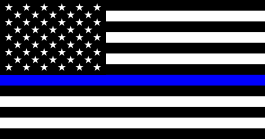The Thin Blue Line (emblem)


The Thin Blue Line is a symbol used by law enforcement, originating in the United Kingdom but now prevalent in the United States and Canada to commemorate fallen and to show support for the living law enforcement officers and to symbolize the relationship of law enforcement in the community as the protectors of fellow civilians from criminal elements.[1] It is an analogy to the term Thin Red Line.
In the United Kingdom, the primary use of the badge is as a mark of respect for fallen police officers / staff. However, it also represents the thin line between order and chaos - this has become a large topic of interest in recent years, as severe cuts to government spending on public services has led to a dramatic decline in the number of police officers and staff in the UK.[2]
In the United States of America, each stripe on the emblem represents certain respective figures: the blue center line represents law enforcement, the top black stripe represents the public and the bottom represents the criminals. The idea behind the graphic is that law enforcement (the blue line) is what stands between the violence and victimization by criminals and the would-be victims of crime.[3]

Proponents of the symbol assert that the identifier is intended to show support for police. In the wake of the 2016 shooting of Dallas police officers, a US flag based version became popular among law enforcement personnel, their families and supporters.[1]
History
The term came into broad use after the release of Errol Morris' 1988 documentary film The Thin Blue Line, about the murder of a Dallas Police officer Robert W Wood. Judge Don Metcalfe who presided over the trial of Randall Adams, states in the film, that prosecutor "Doug Mulder's final argument was one I'd never heard before: about the "thin blue line" of police that separate the public from anarchy." The judge admitted to being deeply moved by the prosecutor's words, though the trial resulted in a wrongful conviction and death sentence.[4]
See also
References
- 1 2 Jack Phillips, “'Thin Blue Line' Flags Appear Across the US”, Epoch Times, 12 July 2016
- ↑ James Murray, “Fury as police told not to wear UK flag badge in memory of colleagues killed” Express, 12 October 2015
- ↑ Brenda Waters, “Thousands Line Canonsburg Streets To Pay Final Respects To Fallen Officer”, CBS local, 16 November 2016
- ↑ http://www.errolmorris.com/film/tbl_transcript.html